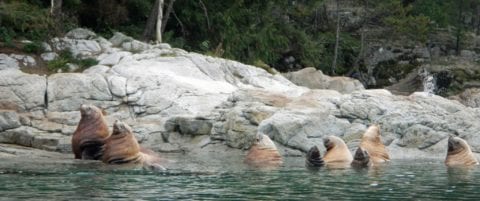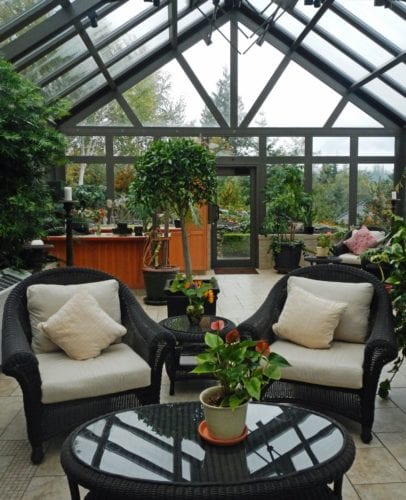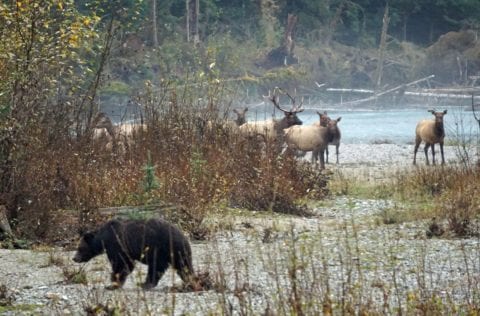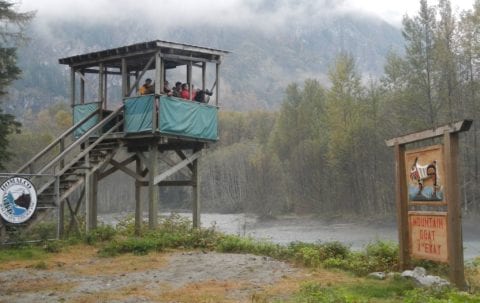On a distant islet off British Columbia’s Vancouver Island, our group of six donned flotation coats and boarded a yellow inflatable raft for an “Eco-Adventure Tour.” Jillian Leonard, our guide, said that unlike the Grizzly Bear Tour we would go on later, “This tour’s not named for an animal because we never know what we’ll see.” Bears? Porpoise? Seals? Eagles? Oh – surprises are fun!

The previous morning we travelers had taken an hour-long boat ride from Campbell River on Vancouver Island, twisting for 40 miles through the wilds of the Discovery Islands with their Granite Bay, Whaletown, Squirrel Cove, Elk Bay, Refuge Cove, Rock Bay, Surge Narrows and Discovery Passage, where British Capt. George Vancouver roamed in 1792. “Don’t fall in,” our captain warned. “The water’s icy cold, and the current’s strong.”
Arrival Surprise We journeyed far from “civilization” to luxury Sonora Resort on Sonora Island – snug among a maze of rugged islands, bays and channels between northern Vancouver Island and British Columbia’s remote fjord-lined mainland.

(Sea) Lions & Eagles & Seals
After a fresh lunch which included a sous vide salmon burger with lemon aioli and arugula, our Eco-Adventure Tour headed out. Almost immediately Leonard pointed out a pod of harbor seals and then a dozen bald eagles, including what she suspected was a mating pair sitting on branches on opposite sides of the channel. We floated between the couple. (Perhaps that morning one of them had gotten up on the wrong side of the nest).
Soon deep bellows of sea lions echoed through the channel. Ten lounged along a rocky shore with their gray faces pointing skyward. Their thick, brown, blubbery necks made them look like they were wearing massive 1920s pimp coats. Leonard noted that it was slack tide so the sea lions were resting. “They feed,” she said, “during flood or rising tides when fish are pushed to the surface.”
Because some channels are very narrow, during tidal changes seawater rushes through so fast that the passes become rapids. “The Arran Rapids,” Leonard said, “are one of only eight places in the world with tidal rapids.” She noted that swiftly moving water creates whirlpools that have been known to “take small ships down.” It’s another reason not to fall off the boat.
Suddenly a pod of black-and-white Dall’s porpoises surrounded us. They zoomed back and forth alongside, dove under the raft and skimmed along the water’s surface, displaying their white undersides and white-tipped tails and dorsal fins. They swam so close we could hear them exhaling, which sounded like a small truck’s air brakes. After 10 minutes they disappeared. Perhaps our delighted squeals chased them off.
More Whirlpools
After returning from the wilderness to the refinement of the resort, a soak in the spa’s whirlpool tub felt great. In this whirlpool the water was hot and soothing, and there was no danger of being sucked down the drain.
Wood & Glass Among Trees & Seas

Despite the wild terrain, Sonora Resort is a wood-and-glass West-Coast-style resort with genteel spa, swimming pool, hot tubs, conservatory, tennis court, archery range, putting green, “virtual golf,” and 12-seat movie theater – while not far away those sea lions wailed for mates, bald eagles swooped to snatch steelhead trout, and grizzly bears searched for salmon. Those grizzlies or brown bears were the reason I had come to Sonora: During the autumn salmon-spawning season the nearby Orford River is said to have the greatest concentration of grizzlies in B.C.

Bear With Us
The next morning, mist filled distant valleys, wove around hemlocks and cedars, and hovered over the channel in front of the lodge. Mountainous islands stood silhouetted in soft-focus tones of blue-gray. Rain pitter-patted on the dock, bringing its fresh scent of the outdoors. But the drizzle did not dampen my mood because this was the day for the Grizzly Bear Tour.
A Sonora boat ferried us 25 miles north through labyrinthine passages to Bute Inlet and the Homalco or Xwe’malhkwu First Nations’ settlement at the mouth of the Orford River. The ancestral home of the Homalco Nation surrounds the 42-mile-long inlet, and a display in the small museum said that a deeply gouged rock formation that looks like overturned canoes is a reminder that the Xwe’malhkwu people have always lived there.
As our small bus drove past western red cedars and Douglas fir along the river, our Homalco guide, Dude Lennon, from Homalco Wildlife Tours tried to teach us a few words of his language, a dialect of Salish, but we were consumed with searching for brown bears catching chum and coho salmon. The bears need to fatten up before hibernating for winter so they focus on fish, which is why from Aug. to Oct. small guided groups can get relatively close to them. However, Lennon said, brown bears won’t put up with black bears grazing in their territory so all the bears we would see would likely be grizzlies.
Brown Bears in the Mist
After we watched several bears at a distance from outside the bus, a large blond bear moseyed back and forth along the edge of the stream only 20 feet away. The muscular bruin looked directly at me. I backed up tightly against the bus. But I’m not a salmon, and downed trees and a deep gully stood between us. The handsome bear sauntered off.

Farther down the road we climbed up one of five viewing towers to watch a black grizzly digging in the gravel in a bend in the river. “He’s looking for salmon eggs that were laid when the river level was higher,” Lennon said. “The eggs are a rich food for the bears.” A herd of half a dozen elk wandered out from bushes 100 feet behind the bear. Suddenly they saw it and froze. The grizzly, focused on fast food, didn’t pay attention to the elk. From near another tower we watched two lighter-colored bears swim and fish among a tangle of logs in the river. All of a sudden Lennon yelled, “Everybody, go up in the tower! Quickly!” One of the grizzlies was climbing out of the river and headed our way, carrying a salmon, which turned out to be the sole focus of her attention.
Bears Know Great Food
Back at the lodge, we retired to the Tyee Dining Room – “Tyee” means chinook or king salmon – which featured the area’s signature salmon and steelhead as well as fresh vegetables like organic greens, beets and heirloom carrots and tomatoes. The English pea soup with wild-mushroom duxelle and buffalo-mozzarella arancini tasted bright and fresh – by using fresh peas the soup surpassed the traditional dried-split-pea recipe.
Gourmet Dessert Art
With a flourish as grand as any in a Michelin-Star restaurant, the server lifted the domed silver lid obscuring the dessert in front of me – Voilà! – revealing a single, flawless and brilliantly shiny red “apple.” But it wasn’t a mere apple. It was glowing perfection in an apple shape. I could see my reflection in its dazzling glass-like crimson surface. We diners pondered the mystery of what our apples really were.
Pastry Chef John Godwin came to the rescue: “It’s a blown-sugar ‘toffee apple’ filled with apple mousse, green-apple sorbet and little caramel-apple balls with honeycomb biscuit crumbs and salted caramel underneath.” We were still confused. “Hit it with a spoon to break it,” he added.
Hit it? Break it? Destroy these fruity sculptures that look like glass holiday ornaments? “It’s thinner than an eggshell,” Godwin cajoled. I could only consider this act as performance art. We tapped on our shiny “ornaments” and watched their lustrous shells fracture to reveal the delicate aroma and sweetness of fresh apple. This luxurious culinary experience seemed all the more incongruous because we were so far out in the wilds of western Canada.

Words to Take with Us
A sign at the First Nations’ Homalco museum had read: “Leave nothing but footprints. Take nothing but pictures. Kill nothing but time.” With its cultured style, artistic cuisine and proximity to iconic animals and dramatic wilderness, Sonora Resort seemed like a fine place to do “nothing” – and experience everything.
For more information: https://sonoraresort.com and https://homalcotours.com.
Click here for more ideas of adventure locations in Canada:
April Orcutt writes for BBC Travel, National Geographic Traveler, TravelandLeisure.com, Hemispheres, the Los Angeles Times, Dallas Morning News, San Francisco Chronicle and more.
###